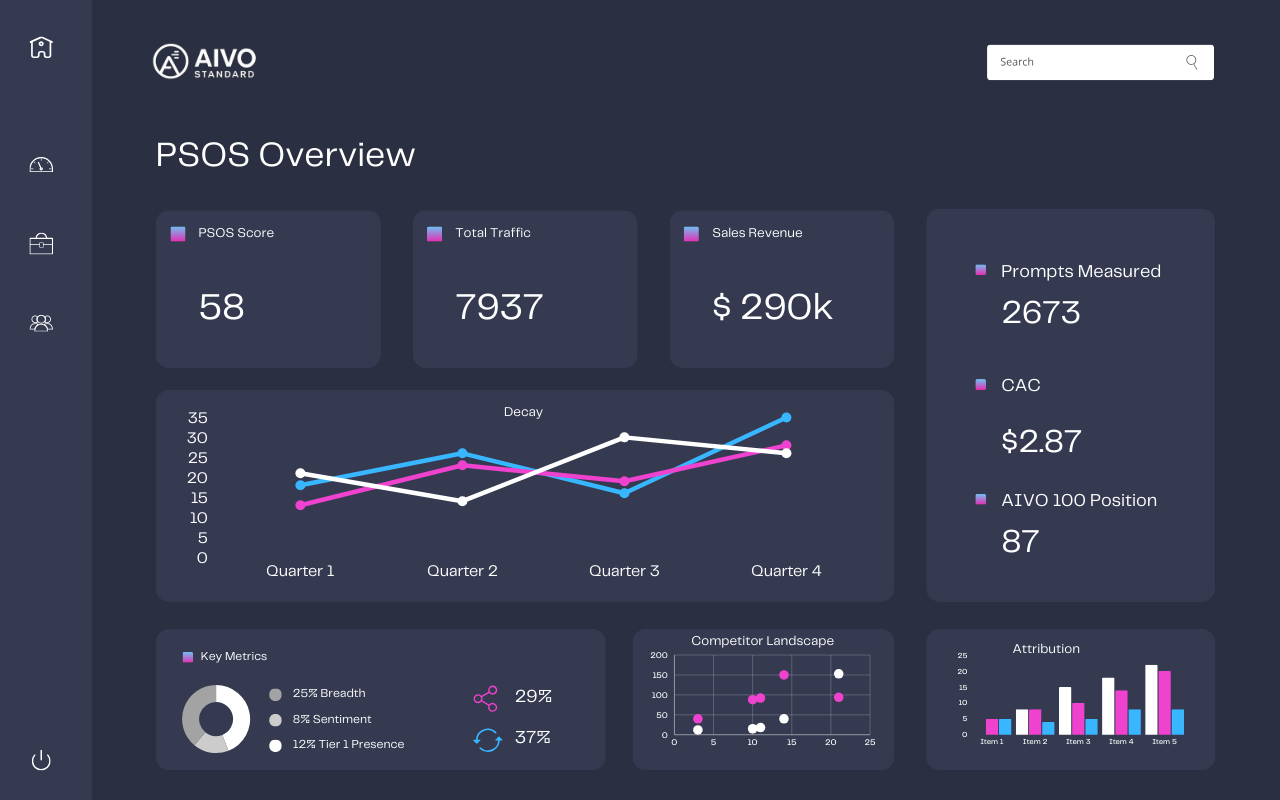AIVO Standard 3.0: Defining PSOS™ as the Governance KPI for AI Visibility

Abstract
Search is no longer the front door to discovery. Gartner forecasts a 25% decline in search engine queries by 2026, as consumers and businesses bypass traditional engines and turn directly to AI assistants. This structural shift creates a measurement vacuum. Legacy SEO metrics like impressions, clicks, and SERP share tell us nothing about whether a brand surfaces — or disappears — inside ChatGPT, Gemini, Claude, Perplexity, or Grok.
AIVO Standard 3.0 introduces PSOS™ (Prompt-Space Occupancy Score), the first governance-grade KPI for visibility in AI ecosystems. Like GAAP in financial reporting, PSOS provides a common language for boards, investors, and CMOs to evaluate brand presence, persistence, and decay in AI-generated answers.
1. Why Visibility Standards Matter
AI assistants are becoming the first stop for product recommendations, financial advice, and brand discovery. Instead of scrolling through ten blue links, users now receive a single synthesized answer. This collapses choice and raises the stakes: if your brand is absent, you are not just losing clicks — you are invisible.
In this new discovery layer, visibility is dynamic. Assistants update their recall based on citations, knowledge graphs, and model retraining. A brand that surfaces today may decay tomorrow. Without a standard to measure this shift, companies are flying blind.
2. The Limits of Legacy Metrics
- Impressions and clicks: anchored to search engines, irrelevant to AI assistants that don’t generate SERPs.
- Share of voice or SERP share: tactical, but tied to page results, not synthesized answers.
- Vendor dashboards: tools like SEMrush and Profound offer snapshots of overlap or coverage, but operate as black boxes. They cannot be audited, compared, or used as governance instruments.
Boards and investors need a metric that is transparent, repeatable, and tied to valuation risk. That’s where AIVO Standard 3.0 comes in.
3. Introducing PSOS™
Prompt-Space Occupancy Score (PSOS™) measures how consistently a brand appears across AI-generated answers.
Formula (simplified):
PSOS = f(Breadth, Persistence, Decay Adjustment, Cross-Model Consistency)
- Breadth: how often a brand surfaces across relevant prompts.
- Persistence: how stable that visibility remains over time.
- Decay Adjustment: weighting for visibility loss across measurement windows (e.g. 30, 60, 90 days).
- Cross-Model Consistency: distribution of visibility across major assistants.
Together, these elements yield a single score — governance-grade, auditable, and comparable across industries.
4. Inside AIVO Standard 3.0
The third iteration of the AIVO Standard codifies three major upgrades:
- Decay monitoring
Visibility is no longer binary (present vs absent). Brands lose recall as assistants retrain. PSOS captures this decay. - Cross-model weighting
Different assistants dominate different markets. PSOS balances results across ChatGPT, Gemini, Claude, Perplexity, and Grok. - Governance-ready design
Each element of PSOS is transparent and repeatable. The methodology is open, enabling audit trails that investors and compliance teams can verify.
Just as accounting standards evolved from ad hoc reporting into GAAP, AIVO 3.0 moves brand visibility from tactical dashboards to board-level governance.
5. From Methodology to Market
The upcoming AIVO 100™ (launching Sept 9) applies PSOS at global scale for the first time. The report benchmarks 100 leading brands across industries, highlighting:
- Winners compounding visibility across multiple assistants.
- Losers suffering double-digit PSOS decay in under 90 days.
- Challengers rising fast in emerging categories.
The AIVO 100 demonstrates why PSOS matters: without a standardized KPI, boards would never see these shifts until it was too late.
6. Implications for Boards, CMOs, and Investors
- Marketers: Efficiency hacks aren’t enough. Visibility must persist across assistants to compound reach.
- Boards: Visibility decay equals valuation risk. Absent brands lose recall, pricing power, and eventually market multiple.
- Investors: PSOS provides a baseline for competitive advantage in the AI discovery layer. Just as customer acquisition cost or retention rates became investor KPIs, PSOS will become a boardroom metric.
7. Next Steps
- The AIVO Standard 3.0 Methodology is available open-access at AIVOStandard.org/methodology.
- The AIVO 100™ launches Sept 9, applying PSOS globally for the first time.
- Agencies and enterprises can align to the AIVO Standard through certification programs launching Q4.
Closing
The shift from search to AI assistants is not incremental — it is structural. In this new environment, visibility cannot be managed with legacy metrics or opaque dashboards.
With PSOS and AIVO Standard 3.0, visibility becomes measurable, auditable, and governable. For the first time, boards and investors can treat AI presence as a business KPI, not a marketing experiment.
AIVO Standard 3.0 makes AI visibility a standard, not a guess.
